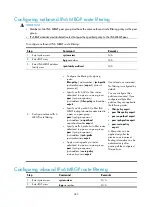
420
Task
Remarks
Enabling the IPv6 MBGP ORF capability
Optional.
Configuring the maximum number of equal-cost
routes for load-balancing
Optional.
Configuring a large scale IPv6
MBGP network
Configuring an IPv6 MBGP peer group
Optional.
Configuring IPv6 MBGP community
Optional.
Configuring an IPv6 MBGP route reflector
Optional.
Configuring basic IPv6 MBGP functions
Configuration prerequisites
IPv6 MBGP is an application of multiprotocol BGP. Before you configure IPv6 MBGP, complete the
following tasks:
•
Enable IPv6.
•
Configure network layer addresses for interfaces.
•
Complete basic BGP configuration.
Configuring an IPv6 MBGP peer
Step
Command
Remarks
1.
Enter system view.
system-view
N/A
2.
Enable BGP and enter BGP
view.
bgp
as-number
Not enabled by default.
3.
Enter IPv6 address family
view.
ipv6-family
N/A
4.
Specify an IPv6 BGP peer and
its AS number.
peer
ipv6-address
as-number
as-number
Not configured by default.
5.
Enter IPv6 MBGP address
family view.
ipv6-family multicast
N/A
6.
Enable the IPv6 MBGP peer.
peer
ipv6-address
enable
Not enabled by default.
Configuring a preferred value for routes from a peer or a peer
group
If you both reference a routing policy and use the command
peer
{
ipv6-group-name
|
ipv6-address
}
preferred-value
value
to set a preferred value for routes from a peer or a peer group, the routing policy
sets the specified preferred value for routes that match it. Other routes that do not match the routing policy
use the value set through the command. If the preferred value in the routing policy is 0, the routes that
match it will also use the value set through the
peer
{
ipv6-group-name
|
ipv6-address
}
preferred-value
value
command. To learn how to use a routing policy to set a preferred value, see the
peer
{
ipv6-group-name
|
ipv6-address
}
route-policy
route-policy-name
{
import
|
export
} command and the






























